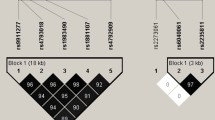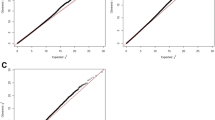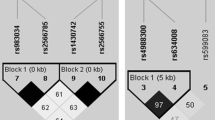Abstract
Gene candidate and genome-wide association studies have revealed tens of loci of susceptibility for osteoporosis. Some limitations such as sample size, use of confounding variables, and control for multiple testing and for population stratification, however, represent common problems in these studies that make replication in independent cohorts desirable and even necessary. The main objective of the present study is to replicate previous data on three functional polymorphisms in a cohort of Spanish women. To that end, we performed an association study of three functional polymorphisms previously associated with bone phenotypes in the LRP5, TNFRSF11B, and FGFBP1 genes with low bone mineral density (BMD) in a cohort of 721 Spanish women, most of them postmenopausal. We detected a strong significant association, even when correcting for multiple comparisons, for polymorphism rs312009 in the LRP5 gene with low BMD at the lumbar-spine site. These were women with the CC genotype, which showed the worst bone parameters. Moreover, these women had a higher risk of osteoporosis (adjusted odds ratio 2.82, P = 0.001) than women with the TT/TC genotype. This association seems to be caused because the rs312009 single nucleotide polymorphism (SNP) is located at a binding site for the transcription factor RUNX2 at the 5′ region of the LRP5 gene, and the T allele seems to be a better transcriber than the C allele. Regarding the other two SNPs, only the rs4876869 SNP in the TNFRSF11B gene showed a suggestive trend for both skeletal sites. These results underscore the significance of the LRP5 gene in bone metabolism and emphasize the significance of the replication of previous results in independent cohorts.
Similar content being viewed by others
References
Kanis JA, Burlet N, Cooper C, Delmas PD, Reginster JY, Borgstrom F, Rizzoli R (2008) European guidance for the diagnosis and management of osteoporosis in postmenopausal women. Osteoporos Int 19:399–428
Ralston SH, Uitterlinden AG (2010) Genetics of osteoporosis. Endocr Rev 31:629–662
van Meurs JB, Trikalinos TA, Ralston SH, Balcells S, Brandi ML et al (2008) Large-scale analysis of association between LRP5 and LRP6 variants and osteoporosis. JAMA 299:1277–1290
Uitterlinden AG, Ralston SH, Brandi ML, Carey AH, Grinberg D et al (2006) The association between common vitamin D receptor gene variations and osteoporosis: a participant-level meta-analysis. Ann Intern Med 145:255–264
Ralston SH, Uitterlinden AG, Brandi ML, Balcells S, Langdahl BL et al (2006) Large-scale evidence for the effect of the COLIA1 Sp1 polymorphism on osteoporosis outcomes: the GENOMOS study. PLoS Med 3:e90
Hsu YH, Kiel DP (2012) Clinical review: genome-wide association studies of skeletal phenotypes: what we have learned and where we are headed. J Clin Endocrinol Metab 97:E1958–E1977
Uitterlinden AG, van Meurs JB, Rivadeneira F, Pols HA (2006) Identifying genetic risk factors for osteoporosis. J Musculoskelet Neuronal Interact 6:16–26
Clevers H, Nusse R (2012) Wnt/beta-catenin signaling and disease. Cell 149:1192–1205
Johnson ML, Gong G, Kimberling W, Recker SM, Kimmel DB, Recker RB (1997) Linkage of a gene causing high bone mass to human chromosome 11 (11q12-13). Am J Hum Genet 60:1326–1332
Gong Y, Vikkula M, Boon L, Liu J, Beighton P et al (1996) Osteoporosis-pseudoglioma syndrome, a disorder affecting skeletal strength and vision, is assigned to chromosome region 11q12-13. Am J Hum Genet 59:146–151
Estrada K, Styrkarsdottir U, Evangelou E, Hsu YH, Duncan EL et al (2012) Genome-wide meta-analysis identifies 56 bone mineral density loci and reveals 14 loci associated with risk of fracture. Nat Genet 44:491–501
Kiel DP, Demissie S, Dupuis J, Lunetta KL, Murabito JM, Karasik D (2007) Genome-wide association with bone mass and geometry in the Framingham Heart Study. BMC Med Genet 8:S14
Richards JB, Kavvoura FK, Rivadeneira F, Styrkarsdottir U, Estrada K et al (2009) Collaborative meta-analysis: associations of 150 candidate genes with osteoporosis and osteoporotic fracture. Ann Intern Med 151:528–537
Rivadeneira F, Styrkarsdottir U, Estrada K, Halldorsson BV, Hsu YH et al (2009) Twenty bone-mineral-density loci identified by large-scale meta-analysis of genome-wide association studies. Nat Genet 41:1199–1206
Agueda L, Velazquez-Cruz R, Urreizti R, Yoskovitz G, Sarrion P, Jurado S, Guerri R, Garcia-Giralt N, Nogues X, Mellibovsky L, Diez-Perez A, Marie PJ, Balcells S, Grinberg D (2011) Functional relevance of the BMD-associated polymorphism rs312009: novel involvement of RUNX2 in LRP5 transcriptional regulation. J Bone Miner Res 26:1133–1144
Marie PJ, Debiais F, Hay E (2002) Regulation of human cranial osteoblast phenotype by FGF-2, FGFR-2 and BMP-2 signaling. Histol Histopathol 17:877–885
Hoppman N, McLenithan JC, McBride DJ, Shen H, Bruder J, Bauer RL, Shaffer JR, Liu J, Streeten EA, Shuldiner AR, Kammerer CM, Mitchell BD (2010) A common variant in fibroblast growth factor binding protein 1 (FGFBP1) is associated with bone mineral density and influences gene expression in vitro. Bone 47:272–280
Simonet WS, Lacey DL, Dunstan CR, Kelley M, Chang MS et al (1997) Osteoprotegerin: a novel secreted protein involved in the regulation of bone density. Cell 89:309–319
Richards JB, Rivadeneira F, Inouye M, Pastinen TM, Soranzo N et al (2008) Bone mineral density, osteoporosis, and osteoporotic fractures: a genome-wide association study. Lancet 371:1505–1512
Vidal C, Formosa R, Xuereb-Anastasi A (2011) Functional polymorphisms within the TNFRSF11B (osteoprotegerin) gene increase the risk for low bone mineral density. J Mol Endocrinol 47:327–333
Pineda B, Hermenegildo C, Laporta P, Tarin JJ, Cano A, Garcia-Perez MA (2010) Common polymorphisms rather than rare genetic variants of the Runx2 gene are associated with femoral neck BMD in Spanish women. J Bone Miner Metab 28:696–705
Pineda B, Tarin JJ, Hermenegildo C, Laporta P, Cano A, Garcia-Perez MA (2011) Gene-gene interaction between CD40 and CD40L reduces bone mineral density and increases osteoporosis risk in women. Osteoporos Int 22:1451–1458
Yuan HY, Chiou JJ, Tseng WH, Liu CH, Liu CK, Lin YJ, Wang HH, Yao A, Chen YT, Hsu CN (2006) FASTSNP: an always up-to-date and extendable service for SNP function analysis and prioritization. Nucleic Acids Res 34:W635–W641
Sole X, Guino E, Valls J, Iniesta R, Moreno V (2006) SNPStats: a web tool for the analysis of association studies. Bioinformatics 22:1928–1929
Gauderman WJ (2002) Sample size requirements for association studies of gene–gene interaction. Am J Epidemiol 155:478–484
Li WF, Hou SX, Yu B, Li MM, Ferec C, Chen JM (2010) Genetics of osteoporosis: accelerating pace in gene identification and validation. Hum Genet 127:249–285
Mitchell BD, Yerges-Armstrong LM (2011) The genetics of bone loss: challenges and prospects. J Clin Endocrinol Metab 96:1258–1268
Duncan EL, Brown MA (2010) Clinical review 2: genetic determinants of bone density and fracture risk—state of the art and future directions. J Clin Endocrinol Metab 95:2576–2587
Hardy J, Singleton A (2009) Genome wide association studies and human disease. N Engl J Med 360:1759–1768
Pearson TA, Manolio TA (2008) How to interpret a genome-wide association study. JAMA 299:1335–1344
Agueda L, Bustamante M, Jurado S, Garcia-Giralt N, Ciria M, Salo G, Carreras R, Nogues X, Mellibovsky L, Diez-Perez A, Grinberg D, Balcells S (2008) A haplotype-based analysis of the LRP5 gene in relation to osteoporosis phenotypes in Spanish postmenopausal women. J Bone Miner Res 23:1954–1963
Mattick JS, Taft RJ, Faulkner GJ (2010) A global view of genomic information—moving beyond the gene and the master regulator. Trends Genet 26:21–28
Acknowledgments
The authors are indebted to Mrs N. Capafons, an undergraduate biology student, and to Mrs R. Aliaga for their excellent technical assistance. This work was supported by Grants PI09/0184 and PI12/02582 from the Fondo de Investigación Sanitaria (FIS, Madrid, Spain). Layla Panach is a predoctoral fellow from the Ministerio de Educación, Cultura y Deporte (Programa de Formación del Profesorado Universitario).
Conflict of interest
All authors have no conflicts of interest.
Author information
Authors and Affiliations
Corresponding author
About this article
Cite this article
Panach, L., Mifsut, D., Tarín, J.J. et al. Replication study of three functional polymorphisms associated with bone mineral density in a cohort of Spanish women. J Bone Miner Metab 32, 691–698 (2014). https://doi.org/10.1007/s00774-013-0539-5
Received:
Accepted:
Published:
Issue Date:
DOI: https://doi.org/10.1007/s00774-013-0539-5




